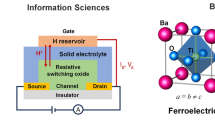Abstract
The following article is based on the Outstanding Young Investigator Award presentation given by Harold Y. Hwang of the University of Tokyo on March 29, 2005, at the Materials Research Society Spring Meeting in San Francisco. Hwang was cited for “innovative work on the physics of transition-metal oxides and the atomic-scale synthesis of complex oxide heterostructures.” Perovskite oxides range from insulators to superconductors and can incorporate magnetism as well as couple to phonon instabilities. The close lattice match between many perovskites raises the possibility of growing epitaxial thin-film heterostructures with different ground states that may compete or interact. The recent development of superconducting Josephson junctions, magnetic tunnel junctions, ferroelectric memory cells, and resistive switching can be considered examples within this new heteroepitaxial family. In this context, Hwang presents his studies of electronic structure at atomically abrupt interfaces grown by pulsed laser deposition. Some issues are generic to all heterointerfaces, such as the stability of dopant profiles and diffusion, interface states and depletion, and interface charge arising from polarity discontinuities. A more unusual issue is the charge structure associated with Mott insulator/band insulator interfaces. The question is, how should one consider the correlated equivalent of band bending? This semiconductor concept is based on the validity of rigid single-particle band diagrams, which are known to be an inadequate description for strongly correlated electrons. In addition to presenting an interesting scientific challenge, this question underlies the attempts to develop new applications of doped Mott insulators in device geometries.
Similar content being viewed by others
References
For example, see N. Tsuda, K. Nasu, A. Fujimori, and K. Siratori, Electronic Conduction in Oxides (Springer-Verlag, Berlin, 2000).
E. Dagotto, Science 309 (2005) p. 257.
J.G. Bednorz and K.A. Mueller, Z. Phys. B 64 (1986) p. 189.
For example, see J.N. Eckstein, I. Bozovic, M.E. Klausmeier-Brown, G.F. Virshup, and K.S. Ralls, MRS Bull. 17 (8) (1992) p. 27.
O. Auciello, J.F. Scott, and R. Ramesh, Phys. Today 51 (7) (1998) p. 22.
For a review, see Y. Tokura, ed., Colossal Magnetoresistive Oxides (Gordon and Breach, New York, 2000).
For example, see H. Koinuma, ed., “Crystal Engineering of High Tc-Related Oxide Films,” MRS Bull. 19 (9) (1994) p. 21.
C. Weisbuch and B. Vinter, Quantum Semiconductor Structures: Fundamentals and Applications (Academic Press, London, 1991).
S.A. Chambers and Y.K. Yoo, eds., “New Materials for Spintronics,” MRS Bull. 28 (10) (2003) p. 706.
K.v. Klitzing, G. Dorda, and M. Pepper, Phys. Rev. Lett. 45 (1980) p. 494.
C.H. Ahn, J.-M. Triscone, and J. Mannhart, Nature 424 (2004) p. 1015.
D.B. Chrisey and G.K. Hubler, eds., Pulsed Laser Deposition of Thin Films (Wiley, New York, 1994).
W. Braun, Applied RHEED (Springer, Berlin, 1999).
G.J.H.M. Rijnders, G. Koster, D.H.A. Blank, and H. Rogalla, Appl. Phys. Lett. 70 (1997) p. 1888.
As an example for Tl-based cuprates, see Y. Shimakawa, Y. Kubo, T. Manako, and H. Igarashi, Phys. Rev. B 40 (1989) p. 11400.
W. Gong, H. Yun, Y.B. Ning, J.E. Greedan, W.R. Datars, and C.V. Stager, J. Solid State Chem. 90 (1991) p. 320.
H.Y. Hwang, A. Ohtomo, N. Nakagawa, D.A. Muller, and J.L. Grazul, Physica E 22 (2004) p. 712.
H.P.R. Frederikse, W.R. Thurber, and W.R. Hosler, Phys. Rev. 134 (1964) p. A442.
J.F. Schooley, W.R. Hosler, and M.L. Cohen, Phys. Rev. Lett. 12 (1964) p. 474.
D.A. Muller, N. Nakagawa, A. Ohtomo, J.L. Grazul, and H.Y. Hwang, Nature 430 (2004) p. 657.
Y. Tokura, Y. Taguchi, Y. Okada, Y. Fujishima, T. Arima, K. Kumagai, and Y. Iye, Phys. Rev. Lett. 70 (1993) p. 2126.
A. Ohtomo, D.A. Muller, J.L. Grazul, and H.Y. Hwang, Nature 419 (2002) p. 378.
A. Ohtomo, D.A. Muller, J.L. Grazul, and H.Y. Hwang, Appl. Phys. Lett. 80 (2002) p. 3922.
D.R. Hamann, unpublished.
For an example of delta-doping in silicon, see P.H. Citrin, D.A. Muller, H.-J. Gossmann, R. Vanfleet, and P.A. Northrup, Phys. Rev. Lett. 83 (1999) p. 3234.
S. Okamoto and A.J. Millis, Nature 428 (2004) p. 630.
See the Nobel Lecture by Herbert Kroemer in G. Ekspong, ed., Nobel Lectures, Physics 1996–2000 (World Scientific, Singapore, 2002).
M. Sugiura, K. Uragou, M. Noda, M. Tachiki, and T. Kobayashi, Jpn. J. Appl. Phys. 38 (1999) p. 2675.
H. Tanaka, J. Zhang, and T. Kawai, Phys. Rev. Lett. 88 027204 (2002).
N. Nakagawa, M. Asai, Y. Mukunoki, T. Susaki, and H.Y. Hwang, Appl. Phys. Lett. 86 082504 (2005).
G.A. Baraff, J.A. Appelbaum, and D.R. Hamann, Phys. Rev. Lett. 38 (1977) p. 237.
W.A. Harrison, E.A. Kraut, J.R. Waldrop, and R.W. Grant, Phys. Rev. B 18 (1978) p. 4402.
A. Ohtomo and H.Y. Hwang, Nature 427 (2004) p. 423.
D.O. Klenov, D.G. Schlom, H. Li, and S. Stemmer, Jpn. J. Appl. Phys. 44 (2005) p. L617.
D.-W. Kim, D.-H. Kim, B.-S. Kang, T.W. Noh, D.R. Lee, and K.-B. Lee, Appl. Phys. Lett. 74 (1999) p. 2176.
Y. Mukunoki, N. Nakagawa, T. Susaki, and H.Y. Hwang, Appl. Phys. Lett. 86 171908 (2005).
Rights and permissions
About this article
Cite this article
Hwang, H.Y. Atomic Control of the Electronic Structure at Complex Oxide Heterointerfaces. MRS Bulletin 31, 28–35 (2006). https://doi.org/10.1557/mrs2006.3
Published:
Issue Date:
DOI: https://doi.org/10.1557/mrs2006.3




